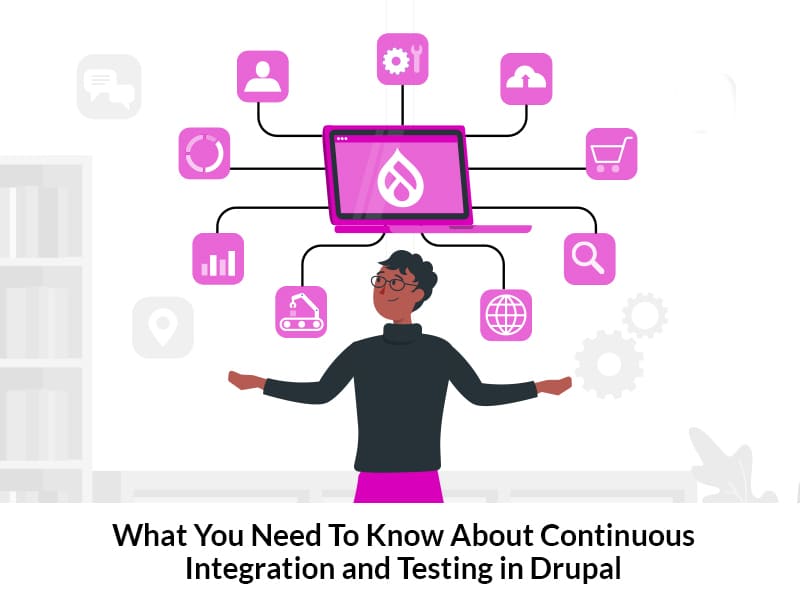Author:
Source
Sponsored:
Working in Public: The Making and Maintenance of Open Source Software - Audiobook

Unlock the Digital Creator Code!
Shubham Gaur
21 Mar, 2023
Drupal is a rapidly growing content management system (CMS). It has 1.3 million users, which is increasing daily. This platform helps in creating different websites, intranets, and web applications. Drupal is a widely used application because it integrates with Continuous Integration and Continuous Testing (CI/CT) tools, which have numerous benefits.
This blog will discuss everything about CI/CT and Drupal.

Importance of Continuous Integration
Continuous testing makes sure that the testing process is easy and automatic. It integrates code changes into a shared repository. Addresses the issue early in the development process and makes finding and removing bugs from the software easier.
Integration is a very important part of the software development method. Here, members of the team have to perform multiple integrations every day. An automated build is used to check those integrations. This automation build includes a test for detecting integration errors faster.
CI helps in testing, reviewing, and integrating the changes into the codebase more quickly and efficiently. Working on isolated code branches can cause several issues. CI prevents those issues and reduces the risk of a merge conflict.
Benefits of Continuous Integration
Continuous Integration is used in Drupal development for a variety of reasons. Some of them are given below.
The key benefits of Using Continuous Integration are:
● Build Automation and Self-testing
Automated environments help in building and launching the system using a single command. Whereas self-testing makes detecting and eradicating the bugs much easier.
● Daily Commits and Integration machine
It is recommended for developers to commit to the machine every day. This way, build tests will be passed immediately, and the correct code will be generated. Integration machines require regular builds and successful build integration.
● Immediate Fix of broken builds and rapid feedback
Continuous build is done to fix the issues in the mainline build immediately. Also, it is necessary to keep the build fast and provide rapid feedback.
● State of the system and Deployment automation
The working of the system should be visible to everyone. The alterations that have been made must be visible to every team member. Deployment automation requires the testers and developers to have scripts. These scripts will help them deploy the application easily into different environments.
How Does Continuous Integration Work?
There are several steps that developers need to follow for successful integration. Alterations must be committed to the repository, and the codes must be thoroughly checked. Developers’ private workspaces must look over the code.
CI server is used to check alterations and build the system. The server runs unit and integration tests and alerts the team members if the build tests fail. The team members fix the issue and continue to test and integrate the project.
The four key steps of CI are code, build, test, and deploy.
- Developers write code and commit changes to a shared code repository.
- A CI server monitors the code repository for changes, and when changes are detected, the server checks out the latest code and builds the software.
- The CI server runs automated tests on the built software to verify that the code changes have introduced no bugs or broken any existing functionality.
- If the tests pass, the CI server may deploy the code changes to a staging or production environment, depending on the organization’s release process.
CI typically involves using a version control system (such as Git or SVN) to manage code changes and a build server (such as Jenkins, Travis CI, or CircleCI) to build and test the code changes. Automation testing is critical to CI, enabling developers to catch and fix bugs introduced by code changes quickly.
By catching problems early in the development process, CI can help teams to reduce the time and cost of software development while also improving the quality and reliability of the software being produced.
What Are The Continuous Integration Tools?
Many Continuous Integration (CI) tools are available, each with strengths and weaknesses. Here are some of the most popular CI tools used by software development teams:
● Jenkins
This is a popular open-source CI tool with a large user community. It can be easily customized with plugins and has integrations with many other tools.
● Travis CI
This cloud-based CI tool is popular for its ease of use and seamless integration with GitHub.
● CircleCI
This cloud-based CI tool is popular for its speed and scalability. It also integrates with many other tools, such as Docker and AWS.
● GitLab CI/CD
This is a built-in CI/CD tool within GitLab, a popular Git repository management system. It is open source and has integrations with many other tools.
● Bamboo
This is a CI/CD tool from Atlassian, the makers of JIRA and Confluence. It has integrations with many other Atlassian tools, as well as other third-party tools.
● TeamCity
This is a CI tool from JetBrains, the makers of IntelliJ IDEA, and other IDEs. Its adaptability and simplicity make it appealing.
● Azure DevOps
This is a cloud-based CI/CD tool from Microsoft. It integrates with many other Microsoft tools, such as Visual Studio and GitHub.
These are just a few of the many CI tools available. When choosing a CI tool, its important to consider factors such as ease of use, integrations with other tools, cost, and the size and complexity of the development team.
Key Practices That Form An Effective Continuous Integration
Here are some key practices that form an effective Continuous Integration (CI) process:
Version Control
A CI process starts with version control, essential for managing code changes, resolving conflicts, and collaborating effectively. Git, SVN, and Mercurial are popular version control systems.
Automated Build
In a CI process, code is always committed to the version control system. It triggers an automated build process to compile and package the code. This ensures that the code builds successfully and eliminates any manual errors.
Automated Testing
Automated testing is a critical component of a CI process. Tests should be automated so that they can be run every time code is committed, and they should cover both functional and non-functional aspects of the application.
Continuous Feedback
CI provides continuous feedback to developers through automated build and test processes. Any issues or failures should be identified and reported immediately to be addressed promptly.
Continuous Deployment
Automated deployment can help reduce the time to get code into production and ensure that the deployment process is consistent and reliable.
Continuous Improvement
A CI process should be constantly monitored and improved. This includes reviewing build and test results, identifying and addressing issues, and optimizing the process to make it faster and more effective.
Effective communication and collaboration among team members are essential for a successful CI process. Developers, testers, and operations personnel should work together closely to identify issues and resolve them quickly.
By following these key practices, teams can implement an effective CI process that helps to ensure high-quality software development and deployment.
What Is Continuous Integration For Drupal?
Continuous integration (CI) for Drupal involves regularly integrating code changes from multiple developers into a shared code repository, building and testing the code changes, and automatically deploying the changes to a testing or staging environment.
Here are some of the key benefits of implementing CI for Drupal:
● Reduced risk
By regularly integrating and testing code changes, CI can help catch and fix errors early in the development cycle, reducing the risk of introducing bugs or breaking functionality.
● Improved collaboration
Developers can collaborate more easily and effectively by working from a shared code repository.
● Faster feedback
With automated testing, developers can get feedback on their code changes quickly, enabling them to make corrections and improvements more rapidly. Different cloud-based testing platforms like LambdaTest can help you achieve faster feedback on code
commits and get a quicker go-to-market.
LambdaTest is a digital experience testing cloud that allows organizations and enterprises to perform manual and automated testing for web and mobile. It offers different offerings like real-time testing, Selenium testing, Cypress testing, Appium testing, OTT testing, testing on real device cloud, and more.
LambdaTest’s online device farm lets you test at scale across 3000+ real browsers, devices, and OS combinations. It also integrates with many CI/CD tools like Jenkins, CircleCI, and Travis CI.
● Consistency
By using consistent tools and processes for development, testing, and deployment, teams can ensure that all code changes are properly vetted and tested before they are deployed to production.
Implementing CI and Testing In Drupal
Like many web application frameworks, Drupal can benefit from continuous integration (CI) and testing practices. Here are some general steps that can be taken to implement CI and test in Drupal:
- Set up a version control system (VCS) such as Git or SVN to manage code changes. All developers should be encouraged to commit their changes to the VCS regularly.
- Use a continuous integration (CI) tool such as Jenkins, Travis CI, or CircleCI to automatically build and test Drupal code changes whenever they are committed to the VCS.
- Write automated Drupal tests using a framework like PHPUnit or Behat. Tests should cover both functional and non-functional aspects of the application.
- Configure the CI tool to run automated tests whenever new code changes are detected. If any tests fail, developers should be notified immediately so they can fix the issue.
- Use tools like CodeSniffer and PHPMD to check for violations of coding standards and best practices.
- Consider using tools like Docker or Vagrant to help automate the setup and configuration of development environments and ensure consistency across development, testing, and production environments.
- There are also contributed modules available for Drupal that can help with testing, such as SimpleTest or the Drupal Extension for Behat.
Final Thoughts
To implement CI for Drupal, development teams can use various tools like Jenkins, Travis CI, or CircleCI and write automated tests using a testing framework such as PHPUnit or Behat. They can also use tools like Docker or Vagrant to help automate the setup and configuration of development environments and ensure consistency across development, testing, and production environments.
Additionally, contributed Drupal modules are available, such as SimpleTest or the Drupal Extension for Behat, which can help test Drupal-specific functionality. By implementing continuous integration and testing practices in Drupal, developers can catch and fix issues early in the development process, leading to faster, higher-quality development and Deployment.














